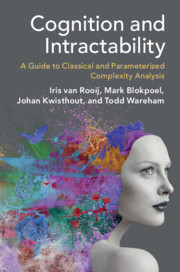Book contents
- Frontmatter
- Contents
- List of Figures
- List of Tables
- Preface
- Part I Introduction
- Part II Concepts and Techniques
- 2 Polynomial versus Exponential Time
- 3 Polynomial-Time Reductions
- 4 Classical Complexity Classes
- 5 Fixed-Parameter Tractable Time
- 6 Parameterized Reductions
- 7 Parameterized Complexity Classes
- Part III Reflections and Elaborations
- Part IV Applications
- Appendix A Mathematical Background
- Appendix B List of Computational Problems
- Appendix C Compendium of Complexity Results
- References
- Index
4 - Classical Complexity Classes
from Part II - Concepts and Techniques
Published online by Cambridge University Press: 18 April 2019
- Frontmatter
- Contents
- List of Figures
- List of Tables
- Preface
- Part I Introduction
- Part II Concepts and Techniques
- 2 Polynomial versus Exponential Time
- 3 Polynomial-Time Reductions
- 4 Classical Complexity Classes
- 5 Fixed-Parameter Tractable Time
- 6 Parameterized Reductions
- 7 Parameterized Complexity Classes
- Part III Reflections and Elaborations
- Part IV Applications
- Appendix A Mathematical Background
- Appendix B List of Computational Problems
- Appendix C Compendium of Complexity Results
- References
- Index
Summary
In this chapter we introduce the classical complexity classes P and NP, where P consists of decision problems that are solvable in polynomial time and NP consists of decision problems for which yes-instances are verifiable in polynomial time. We show that the latter problem class contains many problems for which it is conjectured that no polynomial-time algorithm exists. We introduce the formal notions of NP-hardness and NP-completeness to show that a problem is as least as hard as the hardest problems in NP, and we describe why NP-hard problems are considered to be intractable (i.e., not computable in polynomial time). We explain how one can prove that a problem is a member of either P or NP, and how one can use the technique of polynomial-time reduction, introduced and practiced in Chapter 3, to prove NP-hardness and NP-completeness.
- Type
- Chapter
- Information
- Cognition and IntractabilityA Guide to Classical and Parameterized Complexity Analysis, pp. 78 - 107Publisher: Cambridge University PressPrint publication year: 2019



